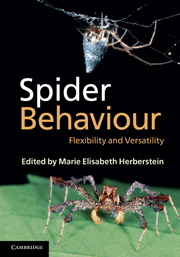Book contents
- Frontmatter
- Contents
- List of contributors
- How this book came about
- 1 Introduction: spider biology
- 2 Flexibility in the foraging strategies of spiders
- 3 Spider webs: evolution, diversity and plasticity
- 4 Flexible use of anti-predator defences
- 5 Communication
- 6 Deceptive signals in spiders
- 7 Mating behaviour and sexual selection
- 8 Group living in spiders: cooperative breeding and coloniality
- 9 Plasticity, learning and cognition
- 10 Kleptoparasitic spiders of the subfamily Argyrodinae: a special case of behavioural plasticity
- Index
- Plate section
- References
2 - Flexibility in the foraging strategies of spiders
Published online by Cambridge University Press: 05 June 2012
- Frontmatter
- Contents
- List of contributors
- How this book came about
- 1 Introduction: spider biology
- 2 Flexibility in the foraging strategies of spiders
- 3 Spider webs: evolution, diversity and plasticity
- 4 Flexible use of anti-predator defences
- 5 Communication
- 6 Deceptive signals in spiders
- 7 Mating behaviour and sexual selection
- 8 Group living in spiders: cooperative breeding and coloniality
- 9 Plasticity, learning and cognition
- 10 Kleptoparasitic spiders of the subfamily Argyrodinae: a special case of behavioural plasticity
- Index
- Plate section
- References
Summary
Although many spiders build prey-capture webs, spider foraging strategies include species that, instead of building webs, deploy silk in other ways for prey capture. Additionally, there are species that capture prey, either by ambush or by active pursuit, without making notable use of silk in the process. There are striking examples of predatory specialisation from spiders, particularly among the Salticidae, suggesting that assumptions about adaptive trade-offs, in which the small nervous systems of spiders might constrain their cognitive or sensory abilities, need to be carefully evaluated. Predatory versatility, whereby an individual spider adopts a conditional strategy with which it classifies prey into diverse categories, illustrates that an individual spider may be a poly-specialist, because it is polyphagic and at the same time it is highly specialised on more than one prey type. More generally, individual flexibility in spider behaviour has important implications concerning the cognitive capacities of predators that orchestrate their strategies using small nervous systems.
Introduction
At first glance, characterising spider foraging might appear straightforward. All spiders are predators, and most frequently the spider's prey is an insect. All spiders produce silk, which is often put to use as part of their predatory arsenal. Yet a closer look reveals staggering diversity – and it is not just variation between species that contributes to this diversity, as we also need to address variation within single species and even within individual spiders.
Information
- Type
- Chapter
- Information
- Spider BehaviourFlexibility and Versatility, pp. 31 - 56Publisher: Cambridge University PressPrint publication year: 2011
References
Accessibility standard: Unknown
Why this information is here
This section outlines the accessibility features of this content - including support for screen readers, full keyboard navigation and high-contrast display options. This may not be relevant for you.Accessibility Information
- 45
- Cited by
